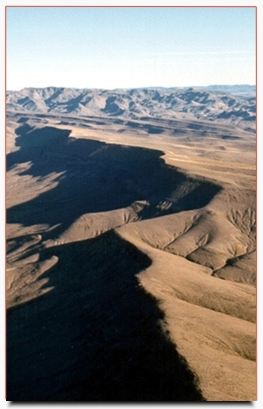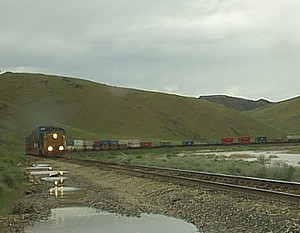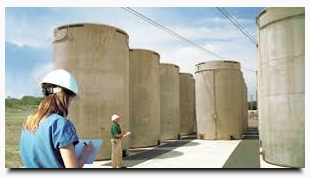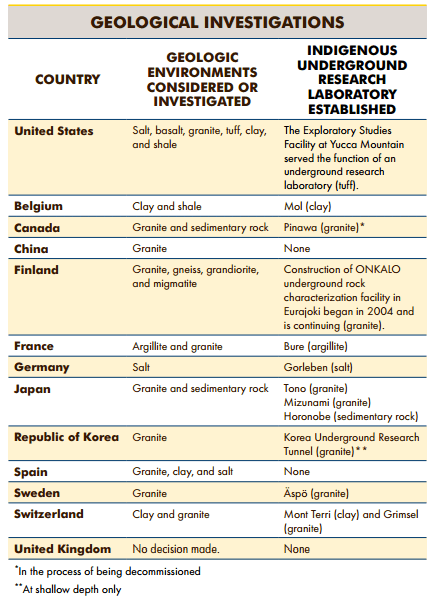
|

|
|
FAQ's Frequently Asked Questions |
|
Current Status of the Yucca Mountain Project
|
|
What are spent nuclear fuel and high-level radioactive waste?
|
|
|
Of note, the Nuclear Waste Policy Act (NWPA) limit for Yucca Mountain is 70,000 metric tonnes heavy metal (MTHM). And based on a DOE decision, 90%, or 63,000 MTHM would be commercial and 7,000 MTHM would be defense waste. MTHM is the original amount of uranium that went into the fuel before it was irradiated in the reactor. Commercial is essentially all spent fuel assemblies. Defense waste is about 2,500 MTHM that was irradiated in a reactor, but had not been reprocessed when reprocessing was halted.
|

Why geologic disposal? Why not other solutions?
|
|
What are the characteristics of the Yucca Mountain site?
|
|
Why Yucca Mountain?
However, the State of Nevada and other groups believe politics played a huge role in the decision. Notably, when the 1987 NWPA amendments were passed, the Speaker of the House of Representatives was Jim Wright, from Texas, and the House majority leader was Tom Foley, from Washington State. Nevada was the smallest and politically weakest state of the three.
|
|
Would a repository at Yucca Mountain protect public health and safety?
For a comparison, a chest X-ray exposes a person to 10 millirem. Americans receive approximately 360 millirem annually from radiation occurring in the environment, from natural sources such as soil, water, and vegetation, and man-made sources like building materials, televisions, and video terminals. (Read the details from EPA or read Read More on this website)
|

How would nuclear waste be transported to Yucca Mountain?
|
|
If the Caliente railroad line is built in Nevada, to transport wast to Yucca Mountain, what impact would it have on the national railroad system?
|
|
What are the national transportation routes?
|
|
Can waste be safely shipped to Yucca Mountain?
|
|
Are the transportation casks safe?
The State of Nevada and other groups remain concerned, however, because these tests are conducted on computer models or on smaller-scale models of the casks. The State has long advocated full-scale testing of several truck and railroad cask designs, as well as rigorous stress testing to determine a cask's breaking point. In May 2004, the NRC authorized new testing of a full-sized cask, but only in a crash and fire scenario. |
|
Will the shipments be secure?
DOE would be required to follow these rules when shipping waste to Yucca Mountain. |
|
What happens if there is a transportation accident?
|
|
Who is liable in case of an accident?
|

How could the transportation of nuclear waste affect property values?
|
|
Would communities know when to expect shipments of spent nuclear fuel and high-level radioactive waste?
|
|
What are the alternatives to Yucca Mountain? What alternative technologies might eliminate the need for a repository?
However, some of these options, such as transmutation and reprocessing, produce liquid high-level waste as a by-product. Although the overall volume of high-level waste would be reduced in these processes, the resulting liquid waste would still need to be dealt with.

Nevada also advocates government management of dry storage facilities, as has occurred at the PECO Peach Bottom Plant in Pennsylvania. In July 2000, DOE and PECO Energy reached an agreement where the government took title to the spent nuclear fuel, but left it in dry storage at PECO's site. The agreement put an end to PECO's lawsuit against the government for not taking the spent fuel by 1998 as had been promised. The State of Nevada says such agreements could effectively end utility rate bases and state utility commissions' jurisdiction and lawsuits, as well as allow utilities to take waste liabilities off their corporate books. |

What are other countries doing about their nuclear waste?
|
|
What happens after the repository closes?
|
|
In The News | Timeline | FAQ's | Special Reports | Licensing Update | Transportation
|
|
|